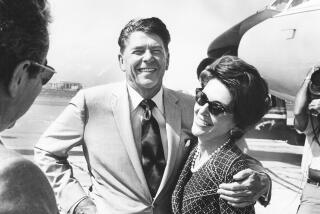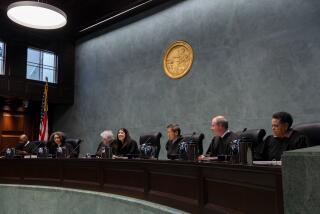Pat Brown: the ‘big-government man’
When Pat Brown took office in 1959, California’s postwar population boom was roaring along full-throttle. The state was adding half a million people a year, and Brown had run for governor as the man who would provide for the multitudes.
During the campaign, numbers that might seem daunting -- the state needed to add 23 new classrooms every day just to keep up with the influx of students, for example -- had been held up as opportunities a Brown administration would seize.
But the state was broke. A soft economy had left the Capitol awash in red ink. The budget gap facing the new governor on inauguration day totaled almost a fifth of the state’s general fund, a shortfall roughly comparable to today’s.
Given what Brown had been calling “our magnificent growth,” draconian budget cuts were out of the question. Even in the midst of such trying times, Brown’s first budget actually increased spending.
For the governor, a Democrat, the solution was not a particularly gut-wrenching decision. The state needed services, and there wasn’t enough money to pay for them. Brown was blunt in his diary: “I have nothing but contempt for those who say that no new taxes are necessary.”
His main proposals were to increase taxes for the wealthy and for corporations, and to impose a new state tax on cigarettes and cigars. All three were adopted, and strikingly, given today’s climate, it was done without extraordinary delays or gridlock. It was far from the most controversial issue of the legislative session.
Today, California’s leaders would face one structural hurdle that didn’t exist for Brown. In the 1950s, a simple majority of legislators could enact a tax increase, rather than the two-thirds required under Proposition 13, which passed in 1978. Brown’s tobacco tax, for instance, didn’t get anywhere near the two-thirds of the votes in the Assembly that it would have needed under today’s requirements.
More important than procedural changes, however, are ideological ones.
In Brown’s day, the country remained in the grip of the so-called New Deal consensus, a mood far more receptive to the idea that government played a constructive role in our society and had to be amply funded. Brown used to say of himself, “I’m a big-government man,” a phrase that would nowadays be uttered by no politician, left, right or center.
It’s true that Republicans tended to be more skeptical of government than Democrats, but they were neither unanimous nor intransigent on the point.
GOP legislators voted for all three big pieces of the Brown tax increase. The corporate tax increase actually drew two-thirds majorities even though the administration had plenty of extra votes and no particular need to twist arms. The income tax hike was only slightly less popular. In the Assembly alone, 11 Republicans voted to raise taxes on corporations, and seven voted to stick it to the rich.
It’s true that tax rates were lower than they are today. Brown’s income tax proposal, for example, raised the top rate from 6% to 7% ; today it is 9%. But still, such active Republican support for any kind of tax increase is unfathomable now.
So I’m quite sure I know what Pat Brown would do if he were governor today, or at least what he would want to do and try to do. He would trumpet government’s positive role, insist that those who benefit the most from our society should pay the most, and set about enacting policies to create a public sector that was funded both fully and fairly. In short, he would raise taxes, especially on the rich.
But the real question is not what Pat Brown would do. Given the differences in ideological climate between his day and ours, the real question is: Would we let him?
Ethan Rarick is the author of “California Rising: The Life and Times of Pat Brown” and “Desperate Passage: The Donner Party’s Perilous Journey West.”
More to Read
Get the L.A. Times Politics newsletter
Deeply reported insights into legislation, politics and policy from Sacramento, Washington and beyond. In your inbox three times per week.
You may occasionally receive promotional content from the Los Angeles Times.










